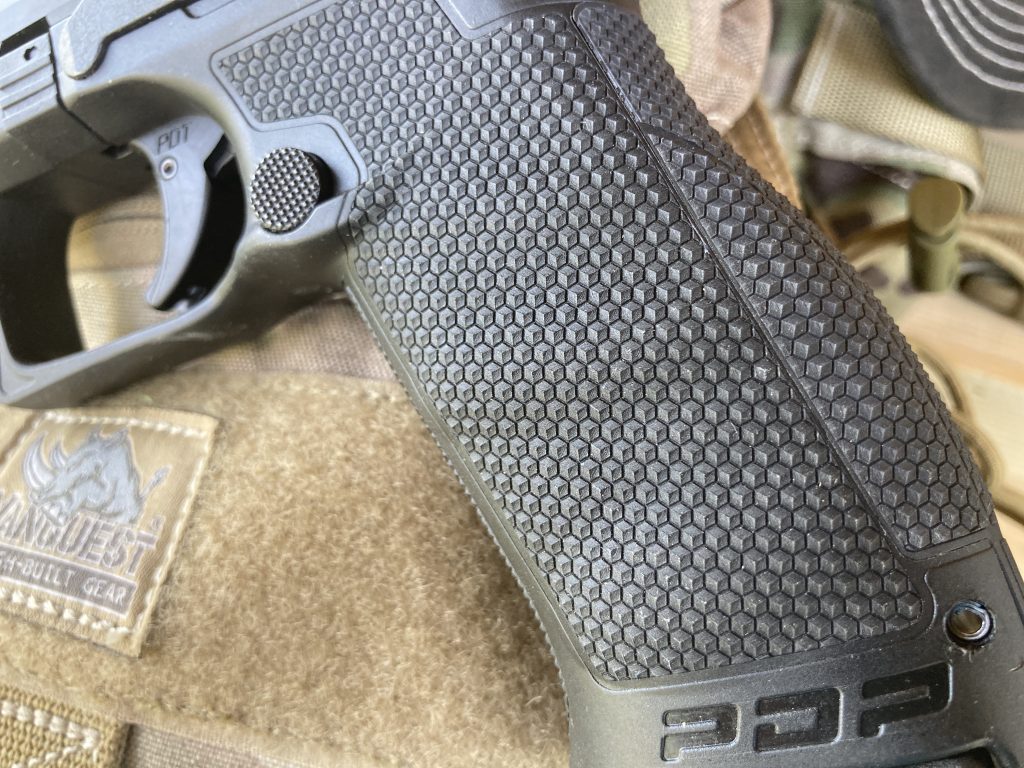German gun maker Walther Arms recently released the Performance Duty Pistol, AKA PDP. So far, the PDP name includes a series of 9mm striker-fired handguns for which modularity and red dot readiness is the name of the game.
PDP variants are called full size and compact; referring to the choice of 15- or 18-round magazines. Ten-round mags are available for each size frame for gun-hating jurisdictions. Two mags are included with purchase. Any PDP frame can accommodate any slide length. Slides are offered in three lengths: 4.0, 4.5 and 5.0 inches. My new PDP sports a full-size frame and 4.5-inch barrel, purchased with the intent of first proving itself to me as a range class gun before graduating to being a security duty sidearm.

The modularity doesn’t end with the frame and slide. As is customary today, there are three backstrap choices. Walther hearkened back to its classic grip profile here. The grip is deeply indented at the top, producing a quite low bore axis and subsequent recoil minimization. The lower half of the grip has a prominent hump, especially using the larger two inserts. (Fans of the cult classic Young Frankenstein probably just heard “what hump?” in their head, as I did when writing this).

Enough about humps. This gun is made with red dot users in mind. Each new PDP comes with a coupon for the user’s choice of one of four mounting plates to fit most red dot brands. After the first, plates must be purchased. This is in contrast to the Canik brand which supplies three plates as a kit upon purchase. Out of the box, a serration-matched cover plate covers the mounting site of the PDP’s slide.
This gun is made not only for mounting a red dot, but for shooting with one. Walther claims the combined ergonomics of the grip angle, firing hand pinky pressure, and support hand pressure facilitate that slight downward tilt necessary to keep an eye on that red dot. Whether a shooter is transitioning to a red dot or is an old hand, this feature should help. Thus far, I’ve only shot my PDP with its iron sights.

For those red dot users who prefer racking the slide in front of the ejection port, or not, Walther lent a hand. The company makes much of its “superterrain serrations” that allegedly raise the serrations above the slide proper. I’ve not perceived much difference in handling between it and other well-textured slides.
The stock sights include a staked white dot front sight (not tritium) and prominent, two-dot rear blade. The latter is adjustable for windage. Plain rear sights might be all the rage right now, but I love the tight sight picture this setup offers. It makes precise hits at distance quickly achievable in comparison to many others that offer too much daylight on either side of the front post. The sights’ high profile means they’ll co-witness with many red dots.
Walther knows triggers, and this pistol is a great reflection of their latest. The Performance Duty Trigger (yep, another acronym: “PDT” is stamped right on the trigger) has a curved face, passive block, and significant take-up on the initial shot. The break is clean, but what’s remarkable is the reset. It’s super-short and walks a perfect line of palpability without vibration. This thing is a friend when it comes to both precision and fast follow-up shots! It’s my favorite feature of the PDP.

Aside from the trigger, handling this bulky-looking gun doesn’t feel bulky because of intelligent design. The large, reversible mag release is well within reach of my not-huge thumb. A molded border under the lower half of the magazine release helps prevent unintended pressing of the release. Equally handy is the all-ambi, extended slide lock. Fans of the HK VP series or Walther’s now-discontinued PPQ pistols will find this slide lock familiar.
Rounding out the handling experience is Walther’s trademarked—wait for it—Performance Duty Texture. Hundreds of molded-in pyramidic bumps cover the grip sides and backstrap. The front has traditional checkering. You can’t please everyone with any grip texture, but this one should come close. It’s comparable to the M&P series in terms of grippiness, but without the abrasive feeling I perceive with the Smith & Wessons.

There are a couple downsides to the PDP. The first is magazine availability. The 18-rounders don’t exist on the market as of this writing, eliminating my PDP from consideration as a duty gun. From what I read, at least the 15-rounders are interchangeable with Walther PPQ mags.
This is a bulky, klunky-looking gun, not a star in the looks department, in my opinion. The tall and wide, squared-off slide takes up significant visual real estate when taking aim. Despite this, it’s not a heavy gun, in part because it has a polymer guide rod. Durability of that remains to be seen. For now, handling and shooting it is pure joy. Pretty is as pretty does!
One other factor disturbed me at first, but may not matter to the average person. When I removed the backstrap to try out the other two, I was greeted by an unexpected sight: an oval slot inside the grip bearing the label “TRANSPONDER.” I considered exercising Walther’s generous 30-day, no-questions return policy on the spot. A friend who’s in the business of x-raying pipelines offered to examine the grip. In what turned out to be a very interesting evening of learning what it takes to x-ray steel through 12 feet of rock, I was relieved to discover there is no chip in the slot. My dealer contacted Walther to inquire about this. The answer: the gun was likely an overrun from a police department order and some are RFID-ready to accommodate inventory management within an agency’s armory. While I realize newer duty-size Glocks, M&Ps, and who knows what else sport an obvious chip, it felt like a privacy invasion to find this “resource” hidden inside the backstrap.
With that little bump in the road behind me, I’m looking forward to logging more range time with the PDP. Holsters for it are beginning to show up on the market, so long as they’re sport or concealment-oriented. As of this writing, there are no Level II or III holsters that I can find for the PDP, so my choice is limited to the Blackhawk Omnivore, a Level II holster that accommodates most railed pistols.
Pricing for the PDP was inflated when the guns first appeared on the market. It wasn’t uncommon to see them marked for $700-plus. That has moderated, and the going price for any size PDP currently hovers in the area of $600.
If you’re looking for a high-quality handgun that can help ease your transition to red dot shooting, or for the perfect companion to your favorite red dot, or for one of the best-handling pistols around, the PDP deserves consideration.
To Purchase a Walther PDP new or used, click here and visit www.guns.com
Article review by: Eve Flanigan
Eve is a defensive shooting and lifestyle student, practitioner, and instructor based in the American Southwest. Flanigan holds numerous NRA Instructor certifications and is licensed to instruct New Mexico’s intensive Concealed Carry course. She regularly designs, conducts, and co-teaches classes on concealed carry, introduction to pistol, defensive pistol, basic rifle, last-ditch medical, and use of force for civilian students. Flanigan enjoys competing in run-and-gun biathlons that include carbine and pistol.







